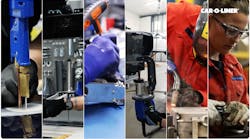RELATED
AFS Trinity Power Corporation recently announced that the company's XH-150 SUV prototypes introduced a year ago at the North American International Auto Show (NAIAS) in Detroit have been substantially upgraded with new technology expected to move America closer to commercial production of 150 mile per gallon full size plug-in hybrid electric SUVs, cars and trucks.
Among the advances announced by AFS Trinity are two new driving modes that offer a previously unavailable combination of fuel economy and performance. Unlike electric vehicles, the company says the new prototypes, designated the XH-150S, have a virtually unlimited range. In one of its operating modes - its all-electric mode - zero gasoline is burned for the first 40 miles enabling 11.5 second 0-60 acceleration and 90 mph highway speed. The second operating mode - the powerful but fuel-efficient gas hybrid mode - automatically switches on when the batteries are 80 percent depleted.
However, the driver can also opt to put the vehicle in gas hybrid mode whenever desired or required, resulting in what is for an SUV a stunning 0-60 acceleration of 6.9 seconds, equal to a Porsche Cayenne, but delivering fuel economy in an SUV of 35 to 65 Miles Per Gallon, depending on whether charge sustaining or charge depleting hybrid operation is enabled.
Reopening U.S. auto plants and saving UAW jobs
AFS Trinity is in the process of applying for $2.5 billion of the $25 billion DOE "green retooling" funding, which new DOE regulations specify is to be spent for " ... reequipping, expanding, and establishing manufacturing facilities in the U.S. to produce advanced technology vehicles and components that demonstrate meaningful improvements in fuel economy."
"To reduce excess capacity US automakers are expected to close at least a dozen of their 53 factories,” AFS Trinity CEO Ed Furia observes. “AFS Trinity would use $2.5 billion of the DOE funding to retool one or more such factories and put laid off UAW workers back to work to produce AFS Trinity's 150 mpg extreme hybrids, resulting in the retention of thousands of auto industry jobs.”
Americans saw the first generation XH-150 prototypes at last year's North American International Auto Show in Detroit where CNN called it "possibly the car of the future." As soon as manufacturing commences and the vehicles become available, first purchasers of the XH-150S are expected to be fleets of law enforcement, fire, military and other business and government users who need a previously unavailable combination of high mileage and high power, the company states. The company also expects that many consumers will find Extreme Hybrid drive train vehicles superior to models currently available.
"Our proprietary technology will now make possible cars, trucks and SUVs that reduce oil dependence and greenhouse gas emissions without giving up utility, comfort or performance,” Furia says. “And we believe this combination of competitive advantages can be central to returning the U.S. auto industry to world leadership," he said.
Tapping lithium battery "sweet spot"
According to AFS Trinity, the dual energy storage system at the heart of the XH-150S uses off-the-shelf lithium ion batteries, buffered by fast, electronic energy storage devices called ultracapacitors that handle high currents during acceleration that would otherwise heavily stress and reduce the useful life of the batteries.
Managed by AFS Trinity's power and control electronics, the batteries operate in the low to moderate power "sweet spot" for which they are optimized, but they can tap the ultracapacitors when high or very high currents are required, thereby eliminating the risk of shortened battery life that unprotected batteries exhibit.
The company's prototype SUVs have proven daily 40 mile 200 HP all-electric range with weekly average fuel consumption equivalent to 150 miles per gallon. Yet, driven as full hybrids, they can tap at will 370 HP for merging onto freeways or passing on a hill - power normally associated with a Porsche Cayenne - not an EV. Most impressive, the majority of American Drivers would travel in this car most days without burning a drop of gasoline.
Furia says, "We call the technology Fast Energy Storage, a dual power system that can be designed into most car, truck and SUV models of virtually all carmakers without diminishing comfort and performance."
For more information visit www.afstrinity.com.

